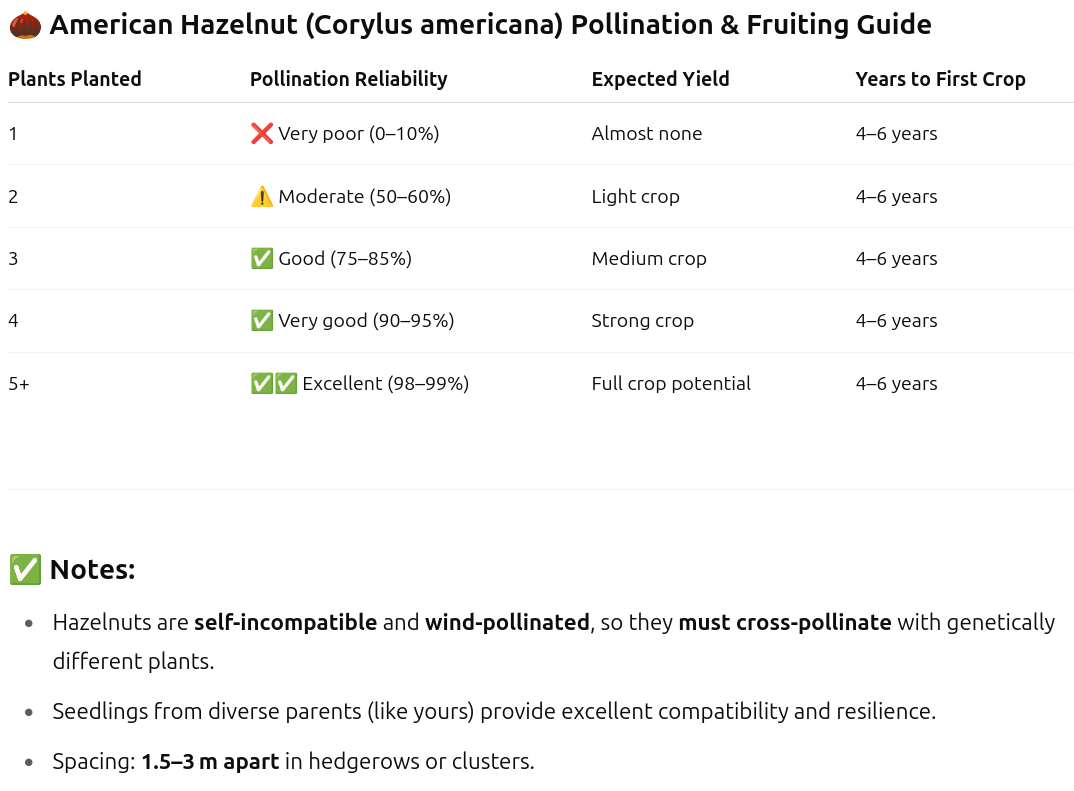Corylus americana, commonly known as the American Hazelnut, is a deciduous shrub native to North America. It typically grows to a height of 2.5-4.5 meters and has a similar spread. This multi-stemmed shrub is recognized by its rounded shape, with leaves that are bright green, rounded to oval, and have doubly serrated edges. During the spring, the American Hazelnut is adorned with yellow male catkins that provide an early source of pollen for bees. By late summer to early autumn, the shrub yields edible nuts encased in a leafy husk, which turn from green to brown as they mature.
Native, tough, and highly nutritious, American hazelnut forms a 2.5тАУ4.5 m multi-stemmed thicket that feeds both wildlife and people. Yellow male catkins brighten late winter; edible nuts ripen AugustтАУSeptember, enclosed in leafy husks that brown at maturity.
The American Hazelnut has been part of North American ecosystems and cultures for centuries. Native American tribes, including the Iroquois, Ojibwa, and Potawatomi, valued the plant not only for its edible nuts but also for its medicinal properties. The nuts were a crucial source of food, especially during the winter months. They were often ground into a meal or paste, which could be used to make cakes or added to soups and stews. The wood of Corylus americana was used in crafting various tools and baskets due to its flexibility and strength.
Indigenous nations relied on the nuts for winter calories, grinding them into meal for cakes and stews; bark infusions eased fever and hives. Today the shrub is valued for:


American Hazelnuts typically start bearing fruit in their 3rd year, with female flowers forming that will produce nuts if successfully pollinated. Male catkins, which provide the pollen, appear around the 5th year, meaning successful pollination and nut production typically begin in the 6th year. Nuts are ready for harvest when the husks turn brown and start to crack open, generally in late summer to early fall.
If local squirrels raid hazelnuts before the husks brown, try one (or a combination) of these tactics тАФ they all work with American hazelnut:
To harvest, simply pluck the ripe nuts from the branches. Alternatively, you can place a tarp or cloth beneath the shrub and shake the branches to dislodge the nuts.
After harvesting, remove the husks from the nuts.
For food storage: Allow the nuts to air-dry for 2-4 weeks in a cool, dry place. Once dried, the nuts can be stored in an airtight container in a cool, dark location for several months. American Hazelnuts are excellent for fresh eating, in baked goods, or for making hazelnut butter or oil.
For seed sprouting: Keep the harvested nuts in a breathable bag or container, and store them in a cool, moist place. The bottom drawer of your refrigerator, for example, is ideal for this. This process is called stratification, and it helps break the seedтАЩs dormancy. After a period of cold stratification for about 90-120 days, the seeds should be ready for planting. If the nut shell cracks easily, itтАЩs usually a good indication that the seed is ready to sprout.
American Hazelnut nuts have numerous culinary uses, from sweet to savory dishes. TheyтАЩre high in healthy fats, protein, and vitamins, making them a nutritious addition to your diet.
Fresh Eating: American Hazelnuts can be eaten fresh after harvest and drying. They have a sweet, slightly buttery flavor that can be enjoyed as is.
Roasted Hazelnuts: Roasting enhances the flavor of the nuts. Preheat your oven to 180░C, spread the hazelnuts on a baking sheet in a single layer, and roast for 10-15 minutes or until theyтАЩre golden and fragrant. After roasting, you can remove the skins by rubbing the nuts in a kitchen towel.
Hazelnut Butter: Blend roasted hazelnuts in a food processor until they form a smooth, creamy butter. This can be spread on toast or used in cooking and baking.
Baking and Desserts: Hazelnuts can be ground into a flour and used in baking. TheyтАЩre a classic ingredient in baked goods like cookies, cakes, and pastries. They also pair well with chocolate, such as in the classic spread, Nutella.
Savory Dishes: Chopped hazelnuts add a pleasing crunch and flavor to salads, pastas, or as a crust for fish or poultry.
In terms of medicinal uses, while more research is needed, some studies suggest that eating hazelnuts may support heart health, aid in blood sugar control, and provide anti-inflammatory and antioxidant benefits.